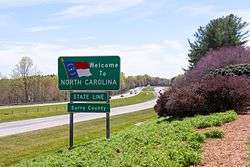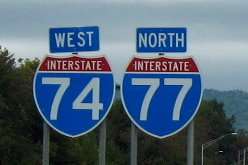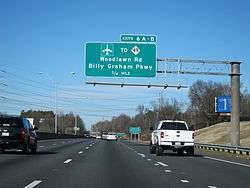Interstate 77 in North Carolina
| ||||
|---|---|---|---|---|
_map.svg.png) | ||||
| Route information | ||||
| Maintained by NCDOT | ||||
| Length: | 105.7 mi[1][2] (170.1 km) | |||
| Existed: | 1965 – present | |||
| Major junctions | ||||
| South end: |
| |||
|
| ||||
| North end: |
| |||
| Location | ||||
| Counties: | Mecklenburg, Iredell, Yadkin, Surry | |||
| Highway system | ||||
| ||||
In the U.S. state of North Carolina, Interstate 77 (I-77) is a 105.7-mile (170.1 km) Interstate Highway, which serves the city of Charlotte and the Western Piedmont. It is part of a highway that goes from Columbia, South Carolina in the south to Cleveland, Ohio in the North, serving as a major link between the Midwest and South Atlantic regions of the U.S.
Route description

Interstate 77 begins at the South Carolina state line, near Fort Mill, in concurrency with US 21. I-77 goes through the city of Charlotte as a major north–south corridor, connecting the Center City with the suburbs of Pineville, Huntersville, Cornelius, and Davidson. Shortly after entering North Carolina, it expands to six lanes. Between I-485 (exit 2) and I-277 (exit 9), the highway experiences massive traffic congestion during weekday rush hours (7:00-9:30 a.m./4:00-6:30 p.m.) due to commuter traffic. Just north of Center City, I-77 makes a unique interchange configuration with Interstate 85, with north and southbound lanes crisscrossing briefly. Between I-85 (exit 13) and I-485 (exit 19), I-77 features the state's only HOV lanes. After I-485, I-77 reduces to five lanes (three lanes northbound), then to four lanes after Gilead Road (exit 23).
At Lake Norman, I-77 crosses into Iredell County and becomes a more suburban interstate, passing by Mooresville and then Statesville, where it intersects with Interstate 40. It turns more rural outside of Statesville and becomes entirely rural after exiting Iredell County. For the rest of I-77's stretch through North Carolina, the only possible rest stop is the town of Elkin; the speed limit through this area is 70 mph (110 km/h). The final 5 miles (8.0 km) of I-77 is concurrent with Interstate 74 to the Virginia state line (where I-74 ends), all within view of the Blue Ridge Mountains.[1]
HOV lanes
Interstate 77 has the first and only High occupancy vehicle (HOV) lanes in North Carolina, located in Mecklenburg County.[3] Opened since December 2004, they are enforced 24 hours a day, seven days a week and are closed for general traffic unless otherwise posted. They are identified by a "diamond" symbol and overhead signs and are located on the leftmost lanes. Vehicles with two or more occupants can use the HOV lanes. Emergency vehicles when responding to emergencies, mass transit vehicles, privately owned buses, and motorcycles may also use the lanes. Violators are subject to a fine of up to $100 plus court costs; as well as two points against their driver's licenses for each HOV infraction.[3] In 2015, construction began on converting the existing HOV lanes into variable tolling lanes, to be completed in 2018.
- Northbound
- The northbound HOV lane begins north of I-85 interchange (exit 13) and ends north of the W.T. Harris Boulevard interchange (exit 18).[3]
- Southbound
- The southbound HOV lane begins south of the W.T. Harris Boulevard interchange (exit 18) ends south of the exit ramp for I-277 (exit 11) and features a bypass of the I-85 interchange.[3]
Dedicated and memorial names
I-77 in North Carolina feature a few dedicated or memorialized stretches of freeway.
- Blue Star Memorial Highway – unofficial North Carolina honorary name of Interstate 77 throughout the state.[4]
- Bill Lee Freeway – official North Carolina name of Interstate 77 from Woodlawn Road to the Mecklenburg-Iredell county line, named for William States Lee III (approved on 5 September 1996).[5]
- Charles M. Shelton Highway – official North Carolina name of Interstate 77 in Surry County (approved on 7 April 2000).[5]
- General Paul R. Younts Expressway – official North Carolina name of Interstate 77 from the South Carolina state line to Woodlawn Road, in Mecklenburg County (approved on 24 June 1965).[5][6]
History

Interstate 77 was not part of the original plans for 714 miles (1,149 km) of the nation's Interstate Highway System in North Carolina when they were conveyed in 1956 by the then-North Carolina State Highway Commission. I-77 was added in 1957, increasing the state's mileage to 776 miles (1,249 km).[7]
On 4 August 1959, the commission selected the routing of I-77 to run between Interstate 85 in Charlotte and a point on the Virginia border in Elkin. That would change in late 1960, when the commission voted to route the highway just west of Mount Airy, saying the route would serve the most people.
With construction beginning in the 1960s, I-77 would gain additional mileage in October 1964 when a two-mile (3 km) extension was granted by the U.S. Bureau of Public Roads. Instead of ending at I-85, I-77 now ended at Independence Boulevard (U.S. 74) in downtown Charlotte. Another extension was granted in the late 1960s that extended I-77 from Independence Boulevard to the South Carolina border. The latest extension also included a relocation of U.S. 21 from the city's surface streets to the new interstate.
I-77 opened to traffic in the following segments:
- 1965: Yadkin and Surry counties.
- 1966: A 23-mile (37 km) stretch in Iredell County.
- 1967: Stretches in Mecklenburg, Yadkin and Iredell counties.
- 1968: A stretch of highway in the Davidson and Cornelius areas in Mecklenburg and Iredell counties.
By 1972, I-77 was open from Exit 28 (NC 73) to Exit 73 north of Elkin. The last two sections of the highway to open to traffic was the stretch from Cornelius to Charlotte in 1975 and from Exit 73 to the Virginia state line in 1977.
In April 2001, I-74 was overlapped with I-77 from the Virginia state line to exit 101.[8]
On December 17, 2004, I-77 was widened to six-lanes with HOV lanes, between I-85 to the proposed location of I-485 (later opened 8 December 2008).[3]
On June 28, 2013, a new interchange was added in Mooresville, exit 35: Brawley School Road. The interchange was built with additional shoulder space and lights that will not need to be moved when I-77 is eventually widened in area.[9]
In 2015, NCDOT signed a contract with I-77 Mobility Partners to begin construction and eventual management of the toll lanes starting in 2018.[10] However, new criticism erupted before the financial agreement was made when local politicians discovered the contract was amended in 2014 giving I-77 Mobility Partners a 50-year non-compete clause. The clause eliminated any future widening of additional free-lanes between Charlotte Center City and Mooresville; or if any additional free-lanes were added, then NCDOT would have to pay the developer compensation.[11][12]
Future

Interstate 77 is planned to have its existing southbound travel lanes widened (not add more lanes), between I-277/NC 16 (Brookshire Freeway) to I-85 in Charlotte. Estimated to cost $16.5 Million, the purpose of the project is to widen the lanes back to proper Interstate standards as agreed with FHWA, when NCDOT were given design exceptions when adding the HOV lanes in 2004. Construction is tentatively scheduled to begin in late 2016.[13]
As of June 2016, HOT lanes are being constructing along Interstate 77. The project is broken into two parts: the first is constructing new travel lanes from I-485 interchange (exit 19) to West Catawba Avenue (exit 28), at an estimated cost of $57 million. The second would be to convert the existing HOV lanes from Brookshire Boulevard (exit 11) to I-485 (exit 19). After completion, drivers and motorcyclists can still use the lane for free if qualified under HOV rules, non-compliant drivers will be charged a toll.[14][15][16][17]
The I-40/I-77 interchange (exit 51) is undergoing a major upgrade in three phases: reconstruction of nearby intersections on both interstates, reconstruction and widening of I-40/I-77 interchange, and construction of new ramps at the interchange. The estimated cost for the entire project is $251 million and construction began in March 2012. It will replace the current interchange, which was built in the late 1960s.[18][19][20]
Auxiliary routes in North Carolina
| Interstate | City | Type | Notes | |
|---|---|---|---|---|
| Interstate 277 | Charlotte | Beltway | A nearly full loop around Charlotte center city |
Exit list
| County | Location | mi[1] | km | Exit | Destinations | Notes |
|---|---|---|---|---|---|---|
| Mecklenburg | State line | 0.0 | 0.0 | Continuation into South Carolina | ||
| Charlotte | 0.9 | 1.4 | 1A | Westinghouse Boulevard | Formerly exit 1 before August 2010 | |
| 1.8 | 2.9 | 1B | Formerly exit 2 (southbound) before August 2010 | |||
| 2.8 | 4.5 | 3 | Arrowood Road | Formerly exit 2 (northbound) before August 2010 | ||
| 3.7 | 6.0 | 4 | Nations Ford Road | |||
| 4.8 | 7.7 | 5 | Tyvola Road | Single-point urban interchange | ||
| 6.0 | 9.7 | 6A | Woodlawn Road south – Queens University | To Pfeiffer University | ||
| 6.2 | 10.0 | 6B | To Billy Graham Library | |||
| 7.3 | 11.7 | 7 | ||||
| 8.3 | 13.4 | 8 | Northbound exit and southbound entrance | |||
| 9.0 | 14.5 | 9A | Southbound exit and northbound entrance | |||
| 9.4 | 15.1 | 9B | ||||
| 9.5 | 15.3 | 9C | ||||
| 9.9 | 15.9 | 10A | Southbound exit and northbound entrance | |||
| 10.4 | 16.7 | 10 | Trade Street / Fifth Street | Signed southbound as exits 10B (east) and 10C (west) | ||
| 11.0 | 17.7 | 11A | ||||
| 11.2 | 18.0 | 11B | Northbound left exit | |||
| 12.4 | 20.0 | 12 | Lasalle Street / Atando Avenue | |||
| 13.3 | 21.4 | 13 | Signed as exits 13A (north) and 13B (south) | |||
| 15.8 | 25.4 | 16 | North end of US 21 overlap; signed as exits 16A (north/east) and 16B (west) To Historic Latta Plantation/Carolina Raptor Center; parclo | |||
| 18.6 | 29.9 | 18 | To Northlake Mall; parclo | |||
| Huntersville | 19.7 | 31.7 | 19 | Signed as exits 19A (north/inner) and 19B (south/outer) | ||
| 23.0 | 37.0 | 23 | Gilead Road – Huntersville | |||
| 25.5 | 41.0 | 25 | ||||
| Cornelius | 28.3 | 45.5 | 28 | South end of US 21 overlap, to be converted into a diverging diamond interchange in August, 2013[21] | ||
| Davidson | 29.8 | 48.0 | 30 | Griffith Street – Davidson | To Davidson College | |
| Iredell | Mooresville | 31.7 | 51.0 | 31 | Langtree Road – Mooresville | |
| 33.3 | 53.6 | 33 | North end of US 21 overlap | |||
| 35.0 | 56.3 | 35 | Brawley School Road | Single-point urban interchange | ||
| 36.2 | 58.3 | 36 | Planned diverging diamond interchange[21] | |||
| | 41.8 | 67.3 | 42 | half-clover interchange | ||
| | 45.5 | 73.2 | 45 | Amity Hill Road – Troutman, Barium Springs | ||
| Statesville | 48.7 | 78.4 | 49A | half-clover interchange | ||
| 49.0 | 78.9 | 49B | Salisbury Road – Downtown Statesville | half-clover interchange | ||
| 50.1 | 80.6 | 50 | East Broad Street – Downtown Statesville | |||
| 51.3 | 82.6 | 51 | Signed as exits 51A (east) and 51B (west); cloverleaf interchange | |||
| | 54.0 | 86.9 | 54 | |||
| | 59.0 | 95.0 | 59 | Tomlin Mill Road – Olin | ||
| | 65.5 | 105.4 | 65 | |||
| Yadkin | Brooks Crossroads | 73.7 | 118.6 | 73 | Signed as exits 73A (south) and 73B (north); cloverleaf interchange | |
| | 79.0 | 127.1 | 79 | South end of US 21 overlap | ||
| Jonesville | 81.9 | 131.8 | 82 | |||
| Surry | Elkin | 83.7 | 134.7 | 83 | North end of US 21 overlap; southbound exit is via exit 85 | |
| 84.8 | 136.5 | 85 | ||||
| | 93.2 | 150.0 | 93 | Zephyr Road – Dobson | ||
| Oak Grove | 100.0 | 160.9 | 100 | |||
| Pine Ridge | 100.8 | 162.2 | 101 | East end of I-74 overlap; semi-directional T interchange | ||
| State line | 105.7 | 170.1 | Continuation into Virginia | |||
1.000 mi = 1.609 km; 1.000 km = 0.621 mi
| ||||||
See also
References
- 1 2 3 Google (27 January 2011). "I-77 in NC" (Map). Google Maps. Google. Retrieved 27 January 2011.
- ↑ "Route Log - Main Routes of the Eisenhower National System Of Interstate and Defense Highways - Table 1". Federal Highway Administration. Retrieved 4 October 2014.
- 1 2 3 4 5 "NCDOT: HOV Lanes". Retrieved 1 November 2011.
- ↑ "NCDOT: NC Blue Star Memorial Marker Locations". Retrieved 19 June 2011.
- 1 2 3 "North Carolina Memorial Highways and other Named Facilities" (PDF). Retrieved 26 August 2012.
- ↑ "General Paul R. Younts Expressway". Retrieved 27 January 2011.
- ↑ North Carolina Department of Transportation. Facts: Interstate 77, NCDOT Web site. Retrieved 21 April 2007.
- ↑ "I-74 Segment 1". Retrieved 2 January 2011.
- ↑ Staff (June 28, 2013). "Opening of Exit 35 on Interstate 77 Signals the End of the Brawley School Road Widening Project in Mooresville". North Carolina Department of Transportation. Retrieved June 28, 2013.
- ↑ "NCDOT Announces Financial Close on I-77 Express Lanes Project" (Press release). North Carolina Department of Transportation. May 20, 2015. Retrieved May 20, 2015.
- ↑ Perlmutt, David (May 19, 2015). "Mecklenburg commissioners side with towns asking for I-77 toll road project delay". The Charlotte Observer. Retrieved May 20, 2015.
- ↑ Harrison, Steve (May 20, 2015). "Toll lane opponent: DOT overlooked best free-lane option". The Charlotte Observer. Retrieved May 20, 2015.
- ↑ "NCDOT: I-77 Improvements - Mecklenburg County". Retrieved 27 January 2011.
- ↑ "NCDOT: Project I-5405". Retrieved 1 November 2011.
- ↑ "HOV lanes will change to toll lanes on I-77". Retrieved 1 November 2011.
- ↑ "I-77 HOV lanes in NC could add toll". Retrieved 1 November 2011.
- ↑ "I-77 Feasibility Study HOV-to-HOT Lanes Conversion" (PDF). Retrieved 1 November 2011.
- ↑ "NCDOT: Project I-3819". Archived from the original on 29 October 2011. Retrieved 1 November 2011.
- ↑ "DOT Report: Interchange At I-40, I-77 To Cost $250M". Retrieved 1 November 2011.
- ↑ "The Construction of I-40/I-77 Interchange" (PDF). Retrieved 1 November 2011.
- 1 2 Marusak, Joe (February 4, 2012). "New interchange planned for bottlenecked I-77 exit". Charlotte, NC: Charlotte Observer. Retrieved March 2, 2013.
External links
 Media related to Interstate 77 in North Carolina at Wikimedia Commons
Media related to Interstate 77 in North Carolina at Wikimedia Commons- NCDOT: I-77 Express Lanes
- NCRoads.com: I-77
- North Carolina @ AARoads - Interstate 77
| Previous state: South Carolina |
North Carolina | Next state: Virginia |
